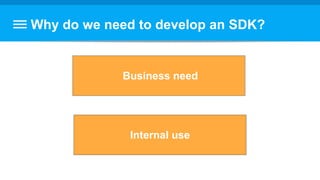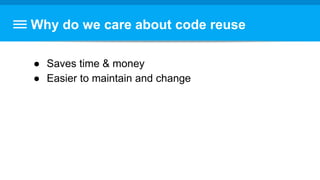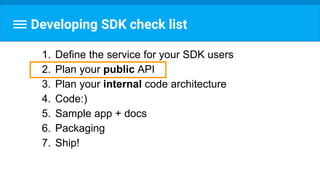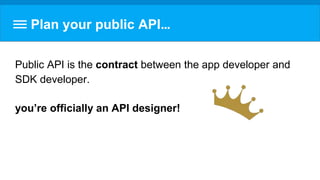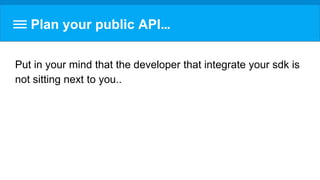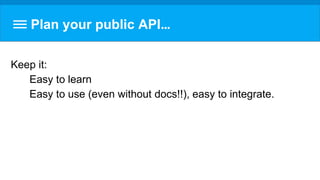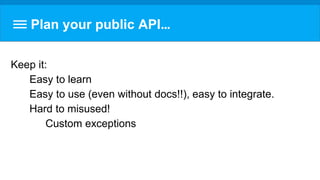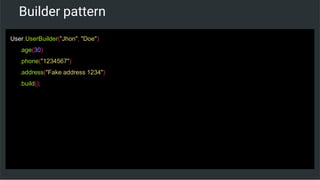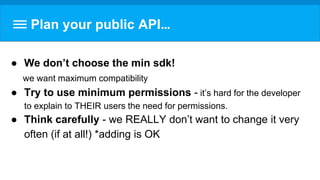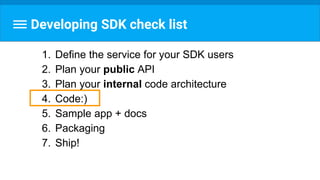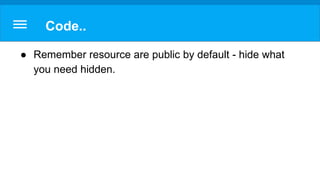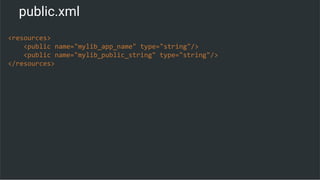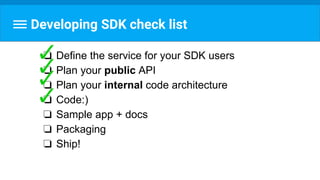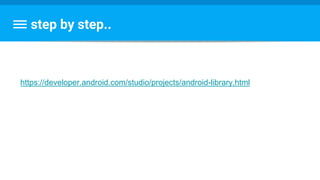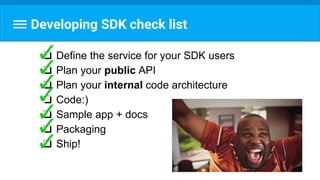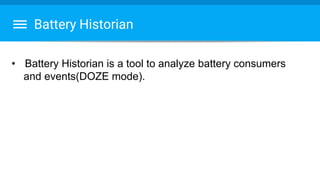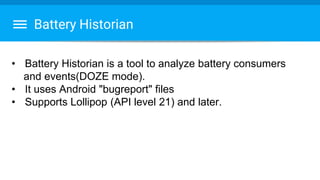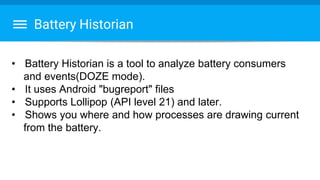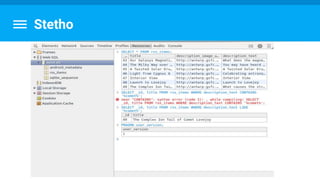How to build Sdk? Best practices
- 1. SDK best practices Rebecca Hamelsdorf 13/9/2017
- 2. Hi!!
- 3. What is SDK
- 4. What is SDK?
- 5. what is SDK? • SDK is a software development kit • It’s a programing package that helps developers to builds application for a specific platform. • Typically it includes one or more API
- 6. Why?
- 7. Why do we need to develop an SDK? Business need
- 8. Why do we need to develop an SDK? But not for business reasons..
- 9. Why do we need to develop an SDK? Business need Internal use
- 11. Why do we care about code reuse ● Saves time & money
- 12. Why do we care about code reuse ● Saves time & money ● Easier to maintain and change
- 13. Why do we care about code reuse ● Saves time & money ● Easier to maintain and change ● Solving bugs in a single place instead of bugs all over the place
- 14. Developing SDK check list 1. Define the service for your SDK users 2. Plan your public API 3. Plan your internal code architecture 4. Code:) 5. Sample app + docs 6. Packaging 7. Ship!
- 15. Developing SDK check list ❏ Define the service for your SDK users ❏ Plan your public API ❏ Plan your internal code architecture ❏ Code:) ❏ Sample app + docs ❏ Packaging ❏ Ship!
- 16. Developing SDK check list 1. Define the service for your SDK users 2. Plan your public API 3. Plan your internal code architecture 4. Code:) 5. Sample app + docs 6. Packaging 7. Ship!
- 17. Plan your public API… Public API is the contract between the app developer and SDK developer. you’re officially an API designer!
- 18. Plan your public API… Put in your mind that the developer that integrate your sdk is not sitting next to you..
- 19. Plan your public API… Keep it: Easy to learn- design for “stupid” developers
- 20. Plan your public API… Keep it: Easy to learn Easy to use (even without docs!!), easy to integrate.
- 21. Someone did it really easy..
- 22. Plan your public API… Keep it: Easy to learn Easy to use (even without docs!!), easy to integrate. Hard to misused!
- 23. Plan your public API… Keep it: Easy to learn Easy to use (even without docs!!), easy to integrate. Hard to misused! Custom exceptions
- 24. Custom Exception class ServerURLException extends RuntimeException { public ServerURLException(String message) { super(message); } }
- 25. Custom Exception class ServerURLException extends RuntimeException { public ServerURLException(String message) { super(message); } } static void isUrlValid(String serverURL) { if( isNullOrEmpty(serverURL) || !isValidUrl(serverURL)) { throw new ServerURLException(“Server URL is invalid or empty"); } }
- 26. Plan your public API… Keep it: Easy to learn Easy to use (even without docs!!), easy to integrate. Hard to misused! Custom exceptions No confusing constructors - use builder pattern, static factory pattern etc.
- 27. Builder pattern public class User { private final String firstName; //required private final String lastName; //required private final int age; //optional private final String phone; //optional private final String address; //optional ... }
- 28. Builder pattern public User(String firstName, String lastName) {this(firstName, lastName, 0);} public User(String firstName, String lastName, int age) {this(firstName, lastName, age, "");} public User(String firstName, String lastName, int age, String phone) { this(firstName, lastName, age, phone, "");} public User(String firstName, String lastName, int age, String phone, String address) { this.firstName = firstName; this.lastName = lastName; this.age = age; this.phone = phone; this.address = address; }
- 29. Builder pattern public class User { private final String firstName; // required private final String lastName; // required private final int age; // optional private final String phone; // optional private final String address; // optional private User(UserBuilder builder) { this.firstName = builder.firstName; this.lastName = builder.lastName; this.age = builder.age; this.phone = builder.phone; this.address = builder.address; } public String getFirstName() { return firstName;} public String getLastName() { return lastName;} public int getAge() { return age;} public String getPhone() { return phone; } public String getAddress() { return address; }
- 30. Builder pattern public class User { private final String firstName; // required private final String lastName; // required private final int age; // optional private final String phone; // optional private final String address; // optional private User(UserBuilder builder) { this.firstName = builder.firstName; this.lastName = builder.lastName; this.age = builder.age; this.phone = builder.phone; this.address = builder.address; } public String getFirstName() { return firstName;} public String getLastName() { return lastName;} public int getAge() { return age;} public String getPhone() { return phone; } public String getAddress() { return address; }
- 31. Builder pattern public static class UserBuilder { private final String firstName; private final String lastName; private int age; private String phone; private String address; public UserBuilder(String firstName, String lastName) { this.firstName = firstName; this.lastName = lastName; } public UserBuilder age(int age) { this.age = age; return this;} public UserBuilder phone(String phone) { this.phone = phone; return this;} public UserBuilder address(String address) { this.address = address; return this; } public User build() { return new User(this); }}}
- 32. Builder pattern User.UserBuilder("Jhon", "Doe") .age(30) .phone("1234567") .address("Fake address 1234") .build();
- 33. Plan your public API… ● Keep it: Easy to learn Easy to use (even without docs!!), easy to integrate. Hard to misused! Custom exceptions No confusing constructors - use builder pattern, static factory pattern etc. Use enums, public static variables when you can.
- 34. Plan your public API… ● We don’t choose the min sdk! we want maximum compatibility
- 35. Plan your public API… ● We don’t choose the min sdk! we want maximum compatibility ● Try to use minimum permissions - it’s hard for the developer to explain to THEIR users the need for permissions.
- 36. Merged Manifest <?xml version="1.0" encoding="utf-8"?> <manifest xmlns:android="http://schemas.android.com/apk/res/android" package="com.academy.myapp"> <application android:allowBackup="true" android:icon="@mipmap/ic_launcher" android:label="@string/app_name" android:roundIcon="@mipmap/ic_launcher_round" android:supportsRtl="true" android:theme="@style/AppTheme"> <activity android:name=".MainActivity"> <intent-filter> <action android:name="android.intent.action.MAIN" /> <category android:name="android.intent.category.LAUNCHER" /> </intent-filter> </activity> </application> </manifest>
- 38. Plan your public API… ● We don’t choose the min sdk! we want maximum compatibility ● Try to use minimum permissions - it’s hard for the developer to explain to THEIR users the need for permissions. ● Think carefully - we REALLY don’t want to change it very often (if at all!) *adding is OK
- 39. Developing SDK check list ❏ Define the service for your SDK users ❏ Plan your public API ❏ Plan your internal code architecture ❏ Code:) ❏ Sample app + docs ❏ Packaging ❏ Ship!
- 40. Developing SDK check list 1. Define the service for your SDK users 2. Plan your public API 3. Plan your internal code architecture 4. Code:) 5. Sample app + docs 6. Packaging 7. Ship!
- 41. Plan your internal code architecture ● Exception handling - the more the merrier :)
- 42. Plan your internal code architecture ● Exception handling - the more the merrier :) ● Use the minimum needed third-party libraries a. we want to keep our SDK light b. we avoid depending on others
- 43. Plan your internal code architecture ● Exception handling - the more the merrier :) ● Use the minimum needed third-party libraries a. we want to keep our SDK light b. we avoid depending on others ● Handle missing permission cases, you are not promised to have them
- 44. Plan your internal code architecture ● Be very mindful to data consumption and battery usage!
- 45. Plan your internal code architecture ● Be very mindful to data consumption and battery usage! ● Remember your support phase during development: ○ Deprecate - don’t kill! ○ Write logs but don’t spam, use 2 log levels (debug/production)
- 46. Developing SDK check list ❏ Define the service for your SDK users ❏ Plan your public API ❏ Plan your internal code architecture ❏ Code:) ❏ Sample app + docs ❏ Packaging ❏ Ship!
- 47. Developing SDK check list 1. Define the service for your SDK users 2. Plan your public API 3. Plan your internal code architecture 4. Code:) 5. Sample app + docs 6. Packaging 7. Ship!
- 48. Code.. ● Remember resource are public by default - hide what you need hidden.
- 49. public.xml <resources> <public name="mylib_app_name" type="string"/> <public name="mylib_public_string" type="string"/> </resources>
- 50. Code.. ● Add unique prefix to resources - the developers may have their own resources that can conflict with yours!
- 51. Code.. ● Add unique prefix to resources - the developers may have their own resources that can conflict with yours! ● Test it on different Kind of apps..
- 52. Code.. ● Add unique prefix to resources - the developers may have their own resources that can conflict with yours! ● Test it on different Kind of apps.. ● you must take the life cycle of the app in consideration!
- 53. Developing SDK check list ❏ Define the service for your SDK users ❏ Plan your public API ❏ Plan your internal code architecture ❏ Code:) ❏ Sample app + docs ❏ Packaging ❏ Ship!
- 54. Developing SDK check list 1. Define the service for your SDK users 2. Plan your public API 3. Plan your internal code architecture 4. Code:) 5. Sample app + docs 6. Packaging 7. Ship!
- 55. Sample app +docs Provide 2 kinds of docs: Simple integration instructions + sample app Api Overview
- 56. Sample app +docs ● Provide 2 kinds of docs: Simple integration instructions + sample app Api Overview • Remember Proguard docs
- 57. proguard.config -keep class javax.** { *; } -keep class org.** { *; } -keep class twitter4j.** { *; }
- 58. Developing SDK check list ❏ Define the service for your SDK users ❏ Plan your public API ❏ Plan your internal code architecture ❏ Code:) ❏ Sample app + docs ❏ Packaging ❏ Ship!
- 59. Developing SDK check list 1. Define the service for your SDK users 2. Plan your public API 3. Plan your internal code architecture 4. Code:) 5. Sample app + docs 6. Packaging 7. Ship!
- 60. Packaging Once we had a jar..
- 61. What can we do? We have AAR!
- 62. What does aar contain? The file extension for an AAR file is .aar, actually the file itself is a zip file containing the following mandatory entries: /AndroidManifest.xml /classes.jar /res/ /R.txt /public.txt There are also optional entries : /assets/ /libs/name.jar /proguard.txt /lint.jar
- 63. Migrate from AAR to JAR .. The file extension for an AAR file is .aar, actually the file itself is a zip file containing the following mandatory entries: /AndroidManifest.xml /classes.jar /res/ /R.txt /public.txt
- 65. Developing SDK check list ❏ Define the service for your SDK users ❏ Plan your public API ❏ Plan your internal code architecture ❏ Code:) ❏ Sample app + docs ❏ Packaging ❏ Ship!
- 66. Developing SDK check list ❏ Define the service for your SDK users ❏ Plan your public API ❏ Plan your internal code architecture ❏ Code:) ❏ Sample app + docs ❏ Packaging ❏ Ship!
- 67. Battery Historian • Battery Historian is a tool to analyze battery consumers and events(DOZE mode).
- 68. Battery Historian • Battery Historian is a tool to analyze battery consumers and events(DOZE mode). • It uses Android "bugreport" files
- 69. Battery Historian • Battery Historian is a tool to analyze battery consumers and events(DOZE mode). • It uses Android "bugreport" files • Supports Lollipop (API level 21) and later.
- 70. Battery Historian • Battery Historian is a tool to analyze battery consumers and events(DOZE mode). • It uses Android "bugreport" files • Supports Lollipop (API level 21) and later. • Shows you where and how processes are drawing current from the battery.
- 72. Battery Historian • https://developer.android.com/studio/profile/battery-historian.html • https://github.com/google/battery-historian
- 73. Stetho • Stetho is a very powerful tool for debugging. • It enables developers have access to the Chrome Developer Tools feature http://facebook.github.io/stetho/
- 74. Stetho
- 75. Questions?









